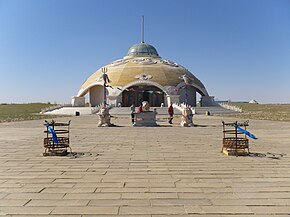
Back شامانية مغولية Arabic Mongolischer Schamanismus German Mongola ŝamanismo Esperanto Chamanismo mongol Spanish شمنباوری مغولی Persian Mongolialainen šamanismi Finnish Chamanisme mongol French Syamanisme Mongolia ID Монголын бөө мөргөл Mongolian Mongolski šamanizem Slovenian

| Part of a series on |
| Mongolian shamanism |
|---|
| Part of a series on |
| Tengrism |
|---|
 |
| A Central Asian–Eurasian Steppe and partly Siberian–East Asian religion |
| Supreme deity |
| Other deities/spirits |
| Movements |
| Related movements |
| People |
| Priests |
| Scriptures |
| Holy places |
| Toponyms |
| Related conceptions |
|
|
Mongolian shamanism, known as the Böö Mörgöl (Бөө мөргөл [pɵː ˈmɵrkʊ̆ɬ]) in Mongolian and more broadly called the Mongolian folk religion[1] or occasionally Tengerism,[2][note 2] refers to the animistic and shamanic ethnic religion that has been practiced in Mongolia and its surrounding areas (including Buryatia and Inner Mongolia) at least since the age of recorded history. In the earliest known stages it was intricately tied to all other aspects of social life and to the tribal organization of Mongolian society. Along the way, it has become influenced by and mingled with Buddhism. During the socialist years of the twentieth century, it was heavily repressed, but has since made a comeback.
Yellow shamanism defines a distinct form of shamanism practiced in Mongolia and Siberia. The term "yellow" in "Yellow Shamanism" is derived from "Yellow Buddhist"; more commonly known as Tibetan Buddhism, this style of Shamanism integrated elements of ritual practice and traditional Buddhist customs. [6] The Gelukpa (or Geluk) school of Buddhism, otherwise known as "Yellow Hat," is one of four major schools (Nyingma, Kagyu, Sakya) established by the early 1400s in Tibetan Buddhism. Similar to the other Buddhist schools, Geluk combined the philosophy and cosmology of Mahayana Buddhism and incorporated distinctive qualities from the Vajrayana teachings to develop and cultivate its own traditions. The term Geluk means, "Order of excellence" or "Virtuous order" in the Tibetan language, which reflects the belief in the institution of the Tulku (incarnate lama) unique only to Tibetan Buddhism. Additionally, the color yellow is a significant color in Tibetan Buddhism, as it represents the color closest to daylight and symbolizes the humility Gautama Buddha displayed in choosing a color previously worn by criminals. [7] Another distinctive quality of Tibetan Buddhism are the yellow pandita hats typically worn by monks. [8][9] The term "yellow shamanism" also serves to distinguish it from a form of shamanism not influenced by Buddhism (according to its adherents), called black shamanism.[10]
Mongolian shamanism revolves around the worship of the "Tngri" (Ancestor spirits) and devotion to "Father sky" otherwise known as "Tenger" or "Qormusta Tengri" in Mongolian. In the Mongolian folk religion, Genghis Khan is considered one of the embodiments, if not the main embodiment, of the Tenger spirit.[11] The Mausoleum of Genghis Khan in Ordos City, in Inner Mongolia, is an important center of this worship tradition.
Cite error: There are <ref group=note> tags on this page, but the references will not show without a {{reflist|group=note}} template (see the help page).
- ^ Heissig 1980, p. 46; Hesse 1987, pp. 403–13.
- ^ Bira 2011; Turner 2016, ch. 9.3 Tengerism.
- ^ Schlehe 2004, pp. 283–96.
- ^ Stausberg, Michael (2010). Religion and Tourism: Crossroads, Destinations and Encounters. Routledge. ISBN 0415549329. p. 162.
- ^ Stewart 1997.
- ^ Shimamura 2004, pp. 649–650.
- ^ Kumar 2004.
- ^ Hesse 1986.
- ^ Shimamura 2004, pp. 649–51.
- ^ Pegg 2001, p. 141.
- ^ Man 2004, pp. 402–404.